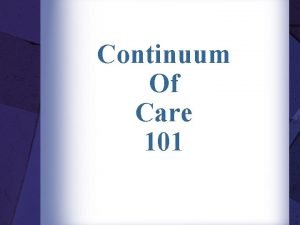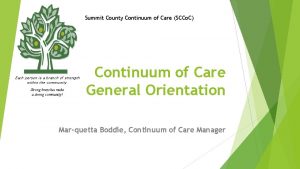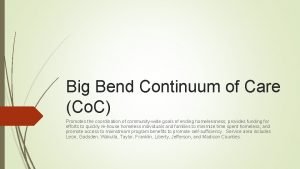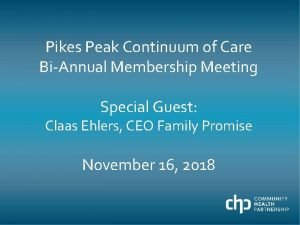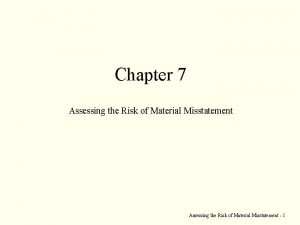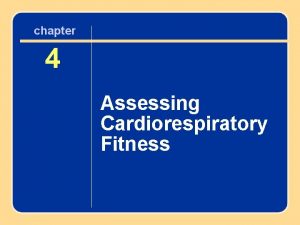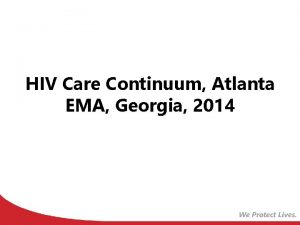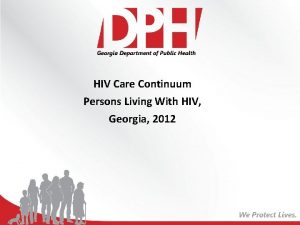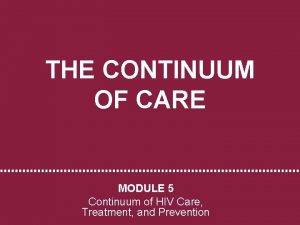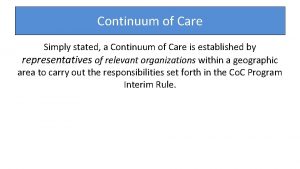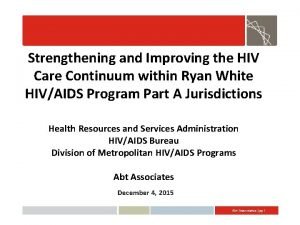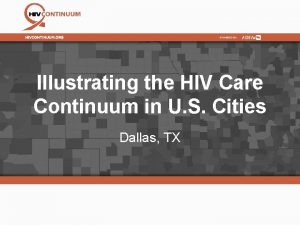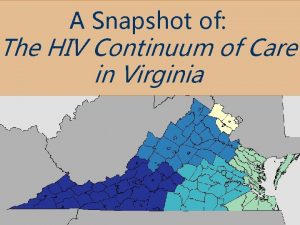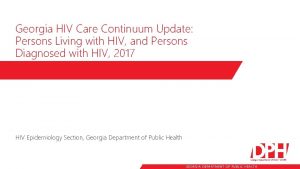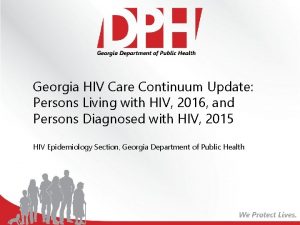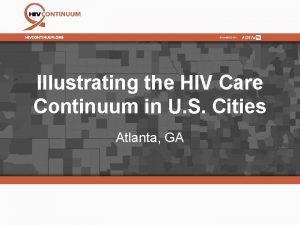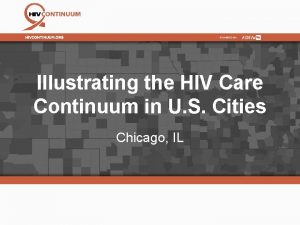July 22 2015 Assessing the HIV Care Continuum















- Slides: 15

July 22, 2015 Assessing the HIV Care Continuum in CCASAnet: progress in clinical retention, ART use, and viral suppression Peter F. Rebeiro, Ph. D, MHS On behalf of: Carina Cesar, Bryan E. Shepherd, Raquel B. De Boni, Claudia Cortés, Fernanda Rodriguez, Pablo Belaunzarán-Zamudio, Jean W. Pape, Denis Padgett, Daniel Hoces, Catherine C. Mc. Gowan, and Pedro Cahn of the Caribbean, Central and South America network for HIV epidemiology (CCASAnet)


Adapted from Ford MA, and Spicer CM. Monitoring HIV care in the United States: indicators and data systems. National Academies Press; 2012. 1. Retention: ≥ 2 HIV primary care encounters per year, >90 days apart Institute of Medicine) 2. ART use: (US ART during the year, among those with ≥ 1 HIV primary care visit during the year (US Department of Health and Human Services) 3. Viral suppression: HIV-1 RNA <200 copies/m. L at the last measurement in the year, among those with ≥ 1 HIV primary care visit during the year (US Department of Health and Human Services)

• CD 4 and VL used as proxies for clinic visit in Argentina and Peru • Haiti excluded from ART outcome, ART use was cohort inclusion criterion • Haiti excluded from viral suppression outcome, VL monitoring not available • Modified Poisson regression with Generalized Estimating Equations (GEE) to account for multiple outcomes per individual • Restricted cubic splines to allow non-linear relationships between age, year of assessment, and outcomes

Characteristics of individuals in CCASAnet contributing to analyses of HIV Care Continuum indicators from 2003 through 2012 Total for Retentiona Characteristic Not Retaineda p-value* (N=18, 799) Total 89, 557 23, 869 65, 688 36. 1 35. 2 36. 4 Age (Years) 0. 21 (30. 0, 43. 0) (29. 3, 41. 7) (30. 3, 43. 5) Sex Male 56, 725 15, 321 (27. 0) 41, 404 (73. 0) Ref. Female 32, 832 8, 548 (26. 0) 24, 284 (74. 0) 0. 24 HIV Risk Factor MSM 25, 553 7, 515 (29. 4) 18, 038 (70. 6) Ref. IDU 1, 555 820 (52. 7) 735 (47. 3) <0. 01 Hetero 28, 938 9, 454 (32. 7) 19, 484 (67. 3) <0. 01 Other/Unk. 33, 511 6, 080 (18. 1) 27, 431 (81. 9) <0. 01 Country Argentinad 18, 878 7, 598 (40. 2) 11, 280 (59. 8) Ref. Brazil 17, 399 4, 922 (28. 3) 12, 477 (71. 7) <0. 01 Chile 11, 938 2, 723 (22. 8) 9, 215 (77. 2) <0. 01 Haitie 4, 279 1, 027 (24. 0) 3, 252 (76. 0) <0. 01 Honduras 23, 074 3, 438 (14. 9) 19, 636 (85. 1) <0. 01 Mexico 3, 933 593 (15. 1) 3, 340 (84. 9) <0. 01 Perud 10, 056 3, 568 (35. 5) 6, 488 (64. 5) <0. 01 Individual Years in Care 7 (4, 9) <0. 01 a. US Institute of Medicine retention indicator: individuals with ≥ 2 HIV primary care encounters per year, >90 days apart d. Argentina and Peru used laboratory measures (CD 4+ counts and HIV-1 RNA measures) as proxies for HIV primary care visits when determining retention status


Characteristics of individuals in CCASAnet contributing to analyses of HIV Care Continuum indicators from 2003 through 2012 Total for ARTb Characteristic Not on ARTb On ARTb p-value* (N=14, 380) Total 68, 877 11, 565 57, 312 35 32. 5 35. 5 Age (Years) <0. 01 (29. 1, 41. 9) (27. 1, 39. 3) (29. 6, 42. 4) Sex Male 49, 101 8, 119 (16. 5) 40, 982 (83. 5) Ref. Female 19, 776 3, 446 (17. 4) 16, 330 (82. 6) 0. 7 HIV Risk Factor MSM 27, 304 5, 079 (18. 6) 22, 225 (81. 4) Ref. IDU 1, 344 203 (15. 1) 1, 141 (84. 9) 0. 25 Hetero 29, 745 4, 800 (16. 1) 24, 945 (83. 9) 0. 17 Other/Unk. 10, 484 1, 483 (14. 2) 9, 001 (85. 9) <0. 01 Country Argentinad 18, 721 3, 549 (19. 0) 15. 172 (81. 0) Ref. Brazil 18, 318 3, 253 (17. 8) 15, 065 (82. 2) 0. 34 Chile 12, 548 2, 282 (18. 2) 10, 266 (81. 8) 0. 8 Haitie N/A N/A Honduras 3, 012 234 (7. 8) 2, 778 (92. 2) <0. 01 Mexico 4, 711 459 (9. 7) 4, 252 (90. 3) <0. 01 Perud 11, 567 1, 788 (15. 5) 9, 779 (84. 5) <0. 01 Individual Years in Care 8 (5, 10) 6 (3, 8) 8 (5, 10) <0. 01 b. c. ART was defined as regimens of ≥ 3 active antiretroviral agents (including triple-nucleoside regimens); US Department of Health and Human Services. ART indicator: number of individuals prescribed ART during the year, among those with ≥ 1 HIV primary care visit during the year e. Haiti did not contribute to the assessment of ART use due to receipt of ART being an inclusion criterion of the clinical cohort; Haiti did not contribute to the assessment of viral suppression due to a lack of universal HIV-1 RNA testing within the clinical cohort


Characteristics of individuals in CCASAnet contributing to analyses of HIV Care Continuum indicators from 2003 through 2012 Total for Viral Suppressionc Characteristic No Viral Suppressionc p-value* (N=13, 330) Total 60, 640 17, 708 42, 932 35. 3 33. 4 35. 9 Age (Years) <0. 01 (29. 3, 42. 1) (27. 6, 40. 2) (30. 0, 42. 9) Sex Male 43, 474 12, 357 (28. 4) 31, 117 (71. 6) Ref. Female 17, 166 5, 351 (31. 2) 11, 815 (68. 8) 0. 11 HIV Risk Factor MSM 24, 026 6, 970 (29. 0) 17, 056 (71. 0) Ref. IDU 1, 191 340 (28. 6) 851 (71. 5) 0. 96 Hetero 25, 965 7, 988 (30. 8) 17, 977 (69. 2) 0. 56 Other/Unk. 9, 458 2, 410 (25. 5) 7, 048 (74. 5) <0. 01 Country Argentinad 17, 282 5, 127 (29. 7) 12, 155 (70. 3) Ref. Brazil 17, 167 5, 215 (30. 4) 11, 952 (69. 6) 0. 78 Chile 10, 116 2, 618 (25. 9) 7, 498 (74. 1) 0. 2 Haitie N/A N/A Honduras 1, 324 167 (12. 6) 1, 157 (87. 4) <0. 01 Mexico 4, 556 778 (17. 1) 3, 778 (82. 9) <0. 01 Perud 10, 195 3, 803 (37. 3) 6, 392 (62. 7) <0. 01 Individual Years in Care 7 (5, 10) 6 (4, 9) 8 (5, 10) <0. 01 c. US Department of Health and Human Services viral suppression indicator: individuals with plasma HIV-1 RNA <200 copies/m. L at the last measurement in the year, among those with ≥ 1 HIV primary care visit during the year e. Haiti did not contribute to the assessment of c. ART use due to receipt of c. ART being an inclusion criterion of the clinical cohort; Haiti did not contribute to the assessment of viral suppression due to a lack of universal HIV-1 RNA testing within the clinical cohort


Modeled relationships between characteristics of CCASAnet patients and HIV Care Continuum indicators from 2003 through 2012, with 95% Confidence Intervals (95% CI) Adjusted* RR (95% CI): ART useb Adjusted* RR (95% CI): Viral Suppressionc 1. 04 (0. 99, 1. 09) 1. 01 (0. 98, 1. 03) Ref. 1. 01 (1. 00, 1. 03) 1. 03 (0. 98, 1. 08) 0. 83 (0. 78, 0. 87) 0. 94 (0. 91, 0. 98) 0. 79 (0. 75, 0. 84) 0. 93 (0. 90, 0. 97) Ref. 1. 03 (1. 01, 1. 05) 1. 05 (0. 99, 1. 12) Ref. 1. 04 (1. 02, 1. 06) 1. 09 (1. 03, 1. 15) Ref. 0. 97 (0. 94, 0. 99) Ref. 0. 97 (0. 93, 1. 00) Ref. 0. 97 (0. 94, 1. 01) Hetero Other/Unk. Ref. 0. 83 (0. 74, 0. 93) 1. 00 (0. 97, 1. 04) 0. 97 (0. 93, 1. 02) Ref. 1. 09 (0. 98, 1. 20) 1. 04 (1. 01, 1. 08) 1. 05 (1. 00, 1. 10) Ref. 1. 03 (0. 93, 1. 15) 1. 01 (0. 97, 1. 05) 1. 03 (0. 97, 1. 08) Years in Care 1. 02 (1. 02, 1. 02) 1. 05 (1. 04, 1. 05) 1. 06 (1. 06, 1. 07) Characteristic Age (Years)d 20 30 40 50 60 Sex Male Female Adjusted* RR (95% CI): Retentiona HIV Risk Factor MSM IDU Bold estimates are statistically significant, p<0. 05 *Fully adjusted models include all terms in table, as well as cohort site and calendar time (modeled with a restricted cubic spline with 4 knots)

Limitations: • Results within CCASAnet may not be generalizable to HIV population not successfully linked/engaged in care in these countries • Additional research is needed to identify social/contextual/economic impediments to achieving positive Care Continuum outcomes, and their causes, in these settings

Conclusions: • HIV Care Continuum outcomes have improved over time in this cohort • Efforts to improve retention should focus on females and IDUs • Efforts to improve ART use should focus on MSM • Efforts to improve ART use and viral suppression should focus on younger individuals

• CCASAnet patients, clinicians, data managers, and investigators • Grant U 01 -AI 069923 -09 from the National Institutes of Health, USA • Hospital Fernandez and Centro Médico Huésped, Buenos Aires, Argentina • Instituto Nacional de Infectologia Evandro Chagas, Fundação Oswaldo Cruz, Rio de Janeiro, Brazil • Fundación Arriarán, Santiago, Chile • Le Groupe Haïtien d'Etude du Sarcome de Kaposi et des Infections Opportunistes, Port-au-Prince, Haiti • Instituto Hondureño de Seguridad Social and Hospital Escuela, Tegucigalpa, Honduras • Instituto Nacional de Ciencias Médicas y Nutrición Salvador Zubirán, Mexico City, México • Instituto de Medicina Tropical Alexander von Humboldt, Lima, Perú • CCASAnet Data Coordinating Center, Vanderbilt University School of Medicine, Nashville, TN, USA

Thank you! Questions?
 Health care levels primary secondary tertiary
Health care levels primary secondary tertiary Continuum of care
Continuum of care Asam continuum of care
Asam continuum of care Continuum care greensboro nc
Continuum care greensboro nc Continuum of care reform
Continuum of care reform Summit county continuum of care
Summit county continuum of care Big bend continuum of care
Big bend continuum of care Care continuum prior authorization
Care continuum prior authorization Continuum of care
Continuum of care Pikes peak continuum of care
Pikes peak continuum of care Child care and protection act 3 of 2015
Child care and protection act 3 of 2015 Dominant work values in today's workforce
Dominant work values in today's workforce Assessing motivation to change
Assessing motivation to change Inherent risk
Inherent risk Assessing cardiorespiratory fitness
Assessing cardiorespiratory fitness Unit 18 assessing children's development support needs p1
Unit 18 assessing children's development support needs p1

